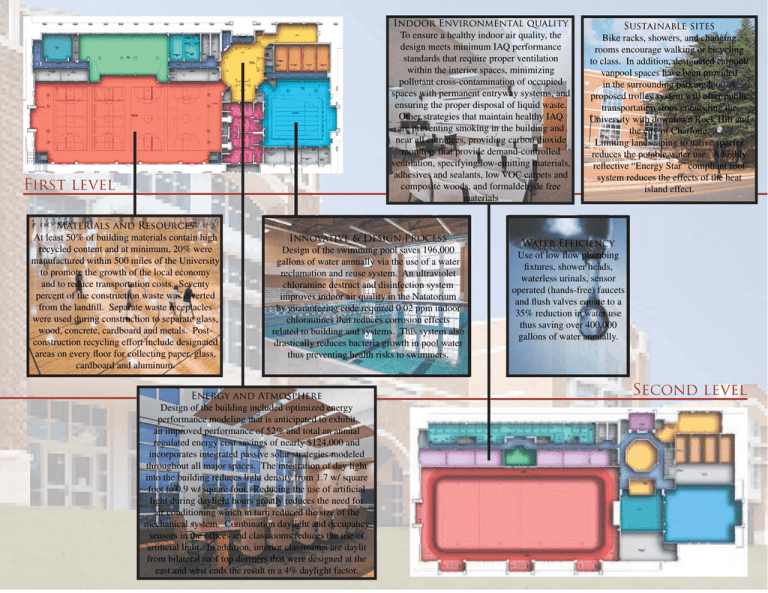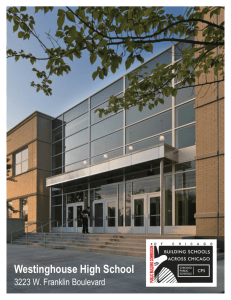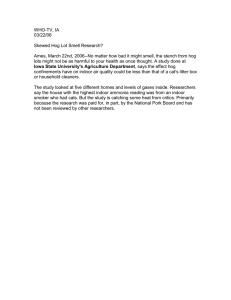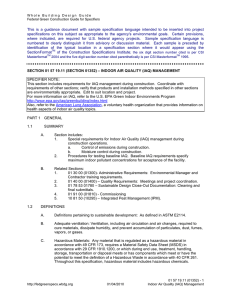Indoor Environmental quality Sustainable sites Bike racks, showers, and changing
advertisement

Indoor Environmental quality To ensure a healthy indoor air quality, the design meets minimum IAQ performance standards that require proper ventilation within the interior spaces, minimizing pollutant cross-contamination of occupied spaces with permanent entryway systems, and ensuring the proper disposal of liquid waste. Other strategies that maintain healthy IAQ are preventing smoking in the building and near all entrances, providing carbon dioxide monitors that provide demand-controlled ventilation, specifying low-emitting materials, adhesives and sealants, low VOC carpets and composite woods, and formaldehyde free materials First level Materials and Resources At least 50% of building materials contain high recycled content and at minimum, 20% were manufactured within 500 miles of the University to promote the growth of the local economy and to reduce transportation costs. Seventy percent of the construction waste was diverted from the landfill. Separate waste receptacles were used during construction to separate glass, wood, concrete, cardboard and metals. Postconstruction recycling effort include designated areas on every floor for collecting paper, glass, cardboard and aluminum. Innovative & Design Process Design of the swimming pool saves 196,000 gallons of water annually via the use of a water reclamation and reuse system. An ultraviolet chloramine destruct and disinfection system improves indoor air quality in the Natatorium by guaranteeing code required 0.02 ppm indoor chloramines that reduces corrosion effects related to building and systems. This system also drastically reduces bacteria growth in pool water thus preventing health risks to swimmers. Energy and Atmosphere Design of the building included optimized energy performance modeling that is anticipated to exhibit an improved performance of 52% and total an annual regulated energy cost savings of nearly $124,000 and incorporates integrated passive solar strategies modeled throughout all major spaces. The integration of day light into the building reduces light density from 1.7 w/ square foot to 0.9 w/ square foot. Reducing the use of artificial light during daylight hours greatly reduces the need for air conditioning which in turn reduced the size of the mechanical system. Combination daylight and occupancy sensors in the offices and classrooms reduces the use of artificial light. In addition, interior classrooms are daylit from bilateral roof top dormers that were designed at the east and west ends the result in a 4% daylight factor. Sustainable sites Bike racks, showers, and changing rooms encourage walking or bicycling to class. In addition, designated carpool/ vanpool spaces have been provided in the surrounding parking lots. A proposed trolley system will offer public transportation stops connecting the University with downtown Rock Hill and the city of Charlotte. Limiting landscaping to native species reduces the potable water use. A highly reflective “Energy Star” compliant roof system reduces the effects of the heat island effect. Water Efficiency Use of low flow plumbing fixtures, shower heads, waterless urinals, sensor operated (hands-free) faucets and flush valves equate to a 35% reduction in water use thus saving over 400,000 gallons of water annually. Second level Project Statement The Lois Rhame West Health, Physical Education and Wellness Center is designed to become a major focal point of Winthrop University’s master plan while exhibiting the University’s ongoing commitment to environmental stewardship. It’s aesthetic references the historic architecture on campus and specifically the 1915 Peabody Gymnasium, which the Lois Rhame West Center replaced. Prior to Peabody’s demolition, much of the wood flooring and several pieces of fixed seating and exercise equipment were salvaged and used in the new facility. As the University’s largest academic building, it provides six classrooms for academic instruction, four indoor basketball courts and two indoor volleyball courts for intramural and sport management training, running track, climbing wall, weight room, two multipurpose rooms for aerobics, and swimming pool for future competitive diving and swimming. Charlotte 500 East Boulevard Charlotte, NC 28203 704.332.7004 research Triangle Park 2530 Meridian Parkway, Suite 300 Durham, NC 27713 919.806.4399 Hilton Head Island 10 Executive Park Road Hilton Head Island, SC 29938 843.785.2199 Colorado 155 East Boardwalk Drive, Suite 300 Fort Collins, CO 80525 970.232.3125 for a sustainable future Lois Rhame West Health, Physical Education and Wellness Center Teaching the community the importance of physical wellness while contributing to a sustainable environment.





